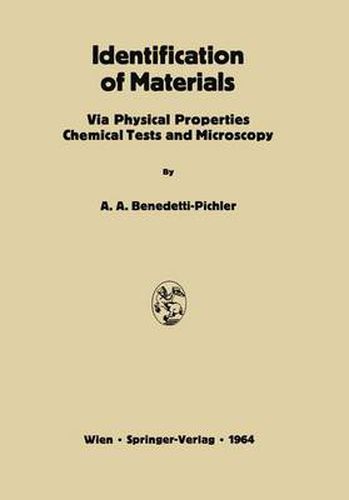Readings Newsletter
Become a Readings Member to make your shopping experience even easier.
Sign in or sign up for free!
You’re not far away from qualifying for FREE standard shipping within Australia
You’ve qualified for FREE standard shipping within Australia
The cart is loading…






This title is printed to order. This book may have been self-published. If so, we cannot guarantee the quality of the content. In the main most books will have gone through the editing process however some may not. We therefore suggest that you be aware of this before ordering this book. If in doubt check either the author or publisher’s details as we are unable to accept any returns unless they are faulty. Please contact us if you have any questions.
This book has been written for the practicing chemist whose occasional task may be qualitative analysis. It deals with the investigation of things as they are without any limitations to the scope. It emphasizes the identification of materials - inorganic, organic, organized (biological), common, rare, described or not described in the accessible literatur- as they actually occur in nature and industry, or are met in the investigation of mishaps and crime. The description of techniques - macro to submicro - and the practice exercises have been included since the teaching of these arts is rarely a part of academic curricula and it happens with increasing frequency that chemists have to acquire them on the job . In the systematic procedure given, emphasis is placed upon the investiga tion of minute specimens and upon acute reasoning that continuously weighs all accumulating evi9.ence. The work begins with the consideration of the history of the material under investigation. Especially when specks of all organic substance shall be identified, it should be realized that the discovery of the source - and consequently of the possibilities involve- may be the most valuable clue to an efficient solution of the problem.
$9.00 standard shipping within Australia
FREE standard shipping within Australia for orders over $100.00
Express & International shipping calculated at checkout
This title is printed to order. This book may have been self-published. If so, we cannot guarantee the quality of the content. In the main most books will have gone through the editing process however some may not. We therefore suggest that you be aware of this before ordering this book. If in doubt check either the author or publisher’s details as we are unable to accept any returns unless they are faulty. Please contact us if you have any questions.
This book has been written for the practicing chemist whose occasional task may be qualitative analysis. It deals with the investigation of things as they are without any limitations to the scope. It emphasizes the identification of materials - inorganic, organic, organized (biological), common, rare, described or not described in the accessible literatur- as they actually occur in nature and industry, or are met in the investigation of mishaps and crime. The description of techniques - macro to submicro - and the practice exercises have been included since the teaching of these arts is rarely a part of academic curricula and it happens with increasing frequency that chemists have to acquire them on the job . In the systematic procedure given, emphasis is placed upon the investiga tion of minute specimens and upon acute reasoning that continuously weighs all accumulating evi9.ence. The work begins with the consideration of the history of the material under investigation. Especially when specks of all organic substance shall be identified, it should be realized that the discovery of the source - and consequently of the possibilities involve- may be the most valuable clue to an efficient solution of the problem.